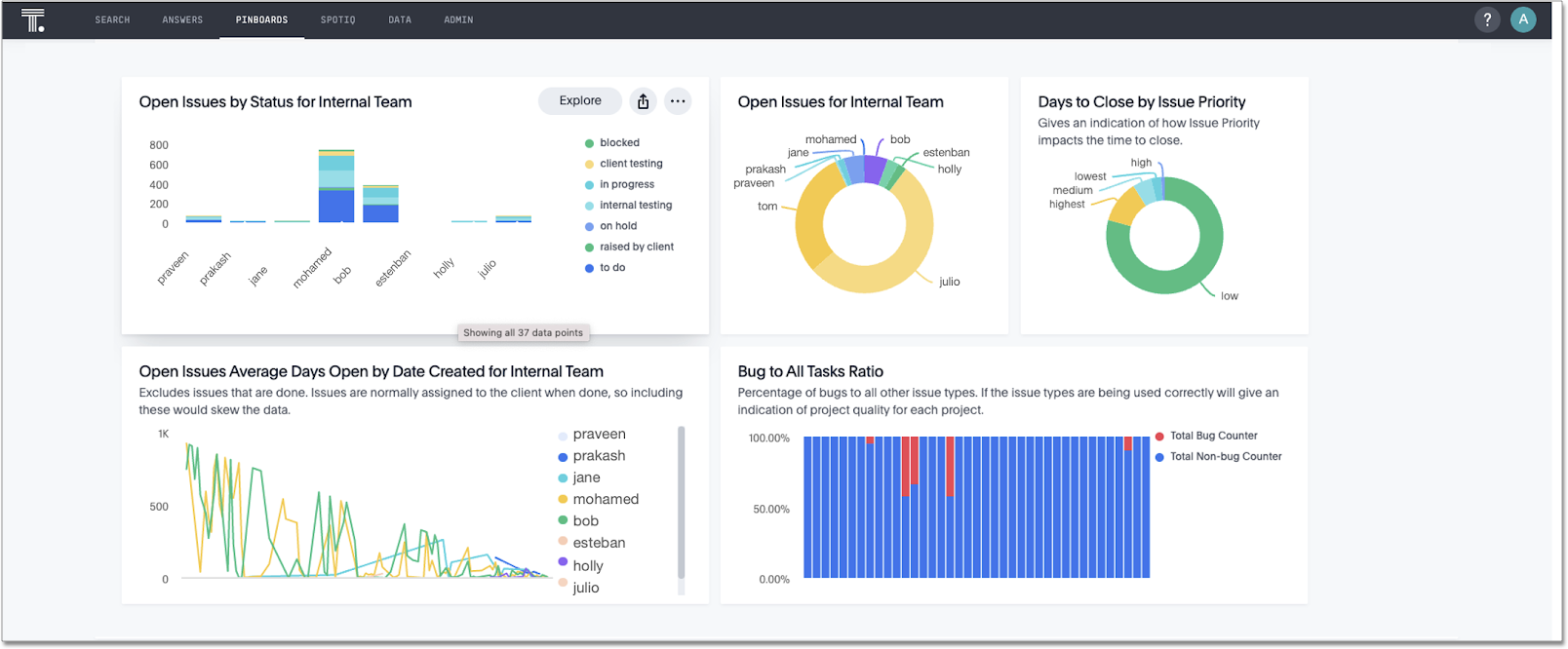Jira Issue Management SpotApp
SpotApps are ThoughtSpot’s out-of-the-box solution templates built for specific use cases and data sources. They are built on ThoughtSpot Modeling Language (TML) Blocks, which are pre-built pieces of code that are easy to download and implement directly from the product.
The Jira Issue Management SpotApp mimics the Jira data model. When you deploy it, ThoughtSpot creates several Worksheets, Answers, and Liveboards, based on your Jira data in your cloud data warehouse.
This is a sample Liveboard, created after you deploy the Jira Issue Management SpotApp:

Use the Jira Issue Management SpotApp to track the number of Jira tickets submitted, and the efficiency of how they are resolved. This can help you determine what part of the workflow causes the most delays, and how each team member is performing at resolving tickets.
Prerequisites
Before you can deploy the Jira Issue Management SpotApp, you must complete the following prerequisites:
-
Review the required tables and columns for the SpotApp.
-
Ensure that your columns match the required column type listed in the schema for your SpotApp.
-
Sync all tables and columns from Jira to your cloud data warehouse. You can sync only the required tables and columns, but ThoughtSpot recommends syncing all tables and columns from Jira to your CDW. The columns can be Jira’s out-of-the-box columns, or any custom columns that you are using instead of the out-of-the-box columns.
If you are using an ETL/ELT tool or working with another team in your organization to move data, our recommendation is that you sync all columns from the tables listed in the SpotApp. -
Obtain credentials and SYSADMIN privileges to connect to your cloud data warehouse. The cloud data warehouse must contain the data you would like ThoughtSpot to use to create Answers, Liveboards, and Worksheets. Refer to the connection reference for your cloud data warehouse for information about required credentials:
-
The connection name for each new SpotApp must be unique.
-
Administrator access to Jira
-
Access to the following Jira tables in your cloud data warehouse. Refer to Jira Issue Management SpotApp schema for more details.
-
JIRA_ISSUES
-
ISSUE
-
PROJECT
-
PRIORITY
-
RESOLUTION
-
STATUS
-
ISSUE_TYPE
-
USER
-
ISSUE_FIELD_HISTORY
-
WORKLOG
-
-
Run the required SQL commands in your cloud data warehouse. Refer to Run SQL commands.
Run SQL commands
The following SQL commands help standardize data types and column names. Replace the database name and schema name with your specific information.
| The following SQL example is for the Snowflake cloud data warehouse. You may need to modify the code for the SQL requirements of your specific cloud data warehouse. |
SQL commands:
Open the dropdown menu to view the SQL commands.
create or replace view "<DATABASE NAME>"."<SCHEMA NAME>"."JIRA_ISSUES" as
select distinct
"ISSUE"."ID" "ID",
"PROJECT"."NAME" "PROJECT_NAME",
"PROJECT"."KEY" "PROJECT_KEY",
"ISSUE"."KEY" "KEY",
"ISSUE_TYPE"."NAME" "ISSUE_TYPE_NAME",
"STATUS"."NAME" "STATUS_NAME",
"PRIORITY"."NAME" "PRIORITY_NAME",
"RESOLUTION"."NAME" "RESOLUTION_NAME",
"RESOLUTION"."DESCRIPTION" "RESOLUTION_DESCRIPTION",
"ISSUE"."RESOLVED" "RESOLUTION_DATE",
"ISSUE"."DESCRIPTION" "DESCRIPTION",
"USER_CREATOR"."NAME" "CREATOR",
"USER_CREATOR"."EMAIL" "CREATOR_EMAIL",
"USER_ASIGNEE"."NAME" "ASSIGNEE",
"USER_ASIGNEE"."EMAIL" "ASSIGNEE_EMAIL",
"USER_REPORTER"."NAME" "REPORTER",
"USER_REPORTER"."EMAIL" "REPORTER_EMAIL",
"ISSUE"."DUE_DATE" "DUE_DATE",
"ISSUE"."CREATED" "CREATED",
"ISSUE"."UPDATED" "UPDATED",
cast("ESTIMATE"."'timeoriginalestimate'" as NUMBER(19,0)) "TIME_ORIGINAL_ESTIMATE",
cast("ESTIMATE"."'timeestimate'" as NUMBER(19,0)) "TIME_ESTIMATE",
"ISSUE_TIME"."TIME_SPENT_SECONDS" "TIME_SPENT_SECONDS",
"ISSUE"."TIME_SPENT" "TIME_SPENT",
"ISSUE"."REMAINING_ESTIMATE" "REMAINING_ESTIMATE",
"ISSUE"."ORIGINAL_ESTIMATE" "ORIGINAL_ESTIMATE",
"ISSUE"."ENVIRONMENT" "ENVIRONMENT",
"ISSUE"."SUMMARY" "SUMMARY"
from
"<DATABASE NAME>"."<SCHEMA NAME>"."ISSUE" "ISSUE"
left outer join "<DATABASE NAME>"."<SCHEMA NAME>"."PROJECT"
on "ISSUE"."PROJECT" = "PROJECT"."ID"
left outer join "<DATABASE NAME>"."<SCHEMA NAME>"."PRIORITY" "PRIORITY"
on "ISSUE"."PRIORITY" = "PRIORITY"."ID"
left outer join "<DATABASE NAME>"."<SCHEMA NAME>"."RESOLUTION" "RESOLUTION"
on "ISSUE"."RESOLUTION" = "RESOLUTION"."ID"
left outer join "<DATABASE NAME>"."<SCHEMA NAME>"."STATUS" "STATUS"
on "ISSUE"."STATUS" = "STATUS"."ID"
left outer join "<DATABASE NAME>"."<SCHEMA NAME>"."ISSUE_TYPE" "ISSUE_TYPE"
on "ISSUE"."ISSUE_TYPE" = "ISSUE_TYPE"."ID"
left outer join "<DATABASE NAME>"."<SCHEMA NAME>"."USER" "USER_ASIGNEE"
on "ISSUE"."ASSIGNEE" = "USER_ASIGNEE"."ID"
left outer join "<DATABASE NAME>"."<SCHEMA NAME>"."USER" "USER_CREATOR"
on "ISSUE"."CREATOR" = "USER_CREATOR"."ID"
left outer join "<DATABASE NAME>"."<SCHEMA NAME>"."USER" "USER_REPORTER"
on "ISSUE"."REPORTER" = "USER_REPORTER"."ID"
left outer join (select * from "<DATABASE NAME>"."<SCHEMA NAME>"."ISSUE_FIELD_HISTORY" pivot(sum("VALUE") for "FIELD_ID" in ('timeestimate','timeoriginalestimate')) as p where "'timeestimate'" is not null) "ESTIMATE"
on "ISSUE"."ID" = "ESTIMATE"."ISSUE_ID"
left outer join "<DATABASE NAME>"."<SCHEMA NAME>"."WORKLOG" "ISSUE_TIME"
on "ISSUE"."ID" = "ISSUE_TIME"."ISSUE_ID";Deploy the Jira Issue Management SpotApp
After you complete the prerequisites, you are ready to deploy the Jira Issue Management SpotApp and begin leveraging its pre-built content.
To deploy the Jira Issue Management SpotApp, refer to Deploying SpotApps.
Jira Issue Management SpotApp schema
The following table describes the schema for the Jira Issue Management SpotApp.
| Table | Column | Column type | Required column |
|---|---|---|---|
JIRA_ISSUES |
CREATED |
TIMESTAMP |
Yes |
JIRA_ISSUES |
ISSUE_TYPE_NAME |
VARCHAR |
Yes |
JIRA_ISSUES |
ID |
NUMBER |
No |
JIRA_ISSUES |
DUE_DATE |
DATE |
No |
JIRA_ISSUES |
KEY |
VARCHAR |
Yes |
JIRA_ISSUES |
RESOLUTION_DATE |
TIMESTAMP |
Yes |
JIRA_ISSUES |
SUMMARY |
VARCHAR |
No |
JIRA_ISSUES |
UPDATED |
TIMESTAMP |
Yes |
JIRA_ISSUES |
PRIORITY_NAME |
VARCHAR |
Yes |
JIRA_ISSUES |
RESOLUTION_NAME |
VARCHAR |
Yes |
JIRA_ISSUES |
PROJECT_KEY |
VARCHAR |
No |
JIRA_ISSUES |
ASSIGNEE |
VARCHAR |
Yes |
JIRA_ISSUES |
CREATOR |
VARCHAR |
Yes |
JIRA_ISSUES |
REPORTER |
VARCHAR |
Yes |
JIRA_ISSUES |
PROJECT_NAME |
VARCHAR |
Yes |
JIRA_ISSUES |
STATUS_NAME |
VARCHAR |
Yes |
JIRA_ISSUES |
TIME_ESTIMATE |
NUMBER |
Yes |
JIRA_ISSUES |
TIME_SPENT_SECONDS |
NUMBER |
Yes |
JIRA_ISSUES |
TIME_ORIGINAL_ESTIMATE |
NUMBER |
Yes |



